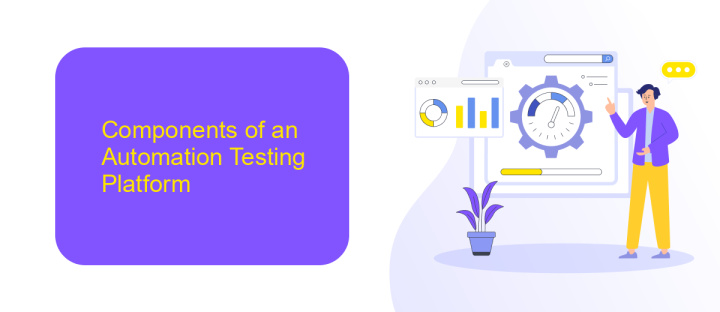Automation Testing Platform
Automation testing platforms have revolutionized the software development landscape by enhancing efficiency, accuracy, and speed in the testing process. These platforms leverage advanced technologies to automate repetitive tasks, allowing developers to focus on more complex issues. By integrating seamlessly into existing workflows, they ensure higher quality software releases, reduced time-to-market, and significant cost savings for businesses.
Introduction
Automation testing platforms have revolutionized the software development lifecycle by providing tools and frameworks that streamline the testing process. These platforms enable developers and QA teams to execute tests more efficiently, ensuring higher quality software with fewer defects. By automating repetitive and time-consuming tasks, teams can focus on more complex testing scenarios and improve overall productivity.
- Increased test coverage and accuracy
- Faster test execution and feedback
- Reduced human error and manual effort
- Enhanced collaboration between development and QA teams
- Scalability to handle large and complex projects
Choosing the right automation testing platform is crucial for achieving these benefits. Factors such as ease of integration, support for multiple testing frameworks, and robust reporting capabilities should be considered. As the demand for high-quality software continues to grow, leveraging automation testing platforms will become increasingly essential for maintaining competitive advantage in the market.
Components of an Automation Testing Platform

An Automation Testing Platform is composed of several key components that work together to ensure efficient and effective testing processes. The first component is the Test Management System, which allows testers to create, organize, and manage test cases and test plans. This system often includes features for tracking test execution and reporting defects. Another crucial component is the Test Execution Engine, responsible for running automated tests on different environments and platforms. This engine ensures that tests are executed consistently and accurately, providing reliable results.
Integration and Continuous Integration/Continuous Deployment (CI/CD) tools are also vital components of an Automation Testing Platform. These tools, such as ApiX-Drive, enable seamless integration with various applications and services, facilitating automated workflows and data synchronization. ApiX-Drive, for instance, allows teams to connect their testing platform with other software tools, ensuring smooth data flow and enhancing collaboration. Additionally, the platform includes Reporting and Analytics tools that provide insights into test results, helping teams identify trends and areas for improvement. Together, these components create a robust framework for automated testing, ensuring high-quality software delivery.
Benefits of Using an Automation Testing Platform

Automation testing platforms have revolutionized the way software testing is conducted, offering numerous advantages that enhance efficiency and accuracy. These platforms are designed to automate repetitive tasks, enabling testers to focus on more complex scenarios and improving overall productivity.
- Increased Test Coverage: Automation allows for the execution of a large number of test cases across various environments, ensuring comprehensive coverage.
- Faster Time-to-Market: Automated tests run significantly faster than manual tests, speeding up the release cycles and reducing time-to-market.
- Consistency and Reliability: Automated tests eliminate human error, providing consistent and reliable results every time they are executed.
- Cost Efficiency: By reducing the need for manual testing, companies can save on labor costs and allocate resources more effectively.
- Reusability of Test Scripts: Once created, automated test scripts can be reused across different projects, saving time and effort in the long run.
In conclusion, adopting an automation testing platform can lead to substantial improvements in software quality and development speed. By leveraging these benefits, organizations can deliver high-quality products more efficiently, staying competitive in a fast-paced market.
Challenges of Implementing an Automation Testing Platform

Implementing an automation testing platform can be a complex and challenging endeavor. One of the primary difficulties lies in the initial setup and configuration, which often requires significant time and resources. Companies must ensure that their testing environment is compatible with the new platform, which may involve updating existing systems and software.
Another major challenge is the need for skilled personnel. Automation testing requires a deep understanding of both the testing tools and the applications being tested. Finding and training staff who possess these skills can be time-consuming and costly. Additionally, maintaining the platform and keeping it up-to-date with the latest testing methodologies and tools is an ongoing effort.
- High initial setup and configuration costs
- Need for skilled personnel and training
- Compatibility issues with existing systems
- Ongoing maintenance and updates
Despite these challenges, the benefits of implementing an automation testing platform can be substantial. By addressing these obstacles proactively, organizations can improve their testing efficiency, reduce human error, and ultimately deliver higher quality software products. Proper planning and resource allocation are key to overcoming these hurdles and achieving successful implementation.
- Automate the work of an online store or landing
- Empower through integration
- Don't spend money on programmers and integrators
- Save time by automating routine tasks
Future of Automation Testing Platforms
The future of automation testing platforms is poised to be driven by advancements in artificial intelligence and machine learning. These technologies will enable testing tools to become more intelligent and predictive, reducing the need for human intervention and increasing accuracy. Automation platforms will be able to learn from past test cases, predict potential failures, and even suggest improvements, making the testing process more efficient and reliable. Additionally, the integration of AI will facilitate more robust test coverage, ensuring that even the most complex applications are thoroughly vetted.
Another significant trend will be the seamless integration of various tools and services, enhancing the overall testing ecosystem. Platforms like ApiX-Drive will play a crucial role in this evolution by providing easy-to-use integration solutions that connect different testing tools and services. This will streamline workflows, reduce manual effort, and improve the speed and quality of testing processes. As a result, teams will be able to focus more on innovation and less on the intricacies of test management, driving faster time-to-market for high-quality software products.
FAQ
What is an Automation Testing Platform?
How does an Automation Testing Platform improve software quality?
What are the key features to look for in an Automation Testing Platform?
How can I integrate an Automation Testing Platform with other tools in my workflow?
Is it necessary to have programming skills to use an Automation Testing Platform?
Apix-Drive is a simple and efficient system connector that will help you automate routine tasks and optimize business processes. You can save time and money, direct these resources to more important purposes. Test ApiX-Drive and make sure that this tool will relieve your employees and after 5 minutes of settings your business will start working faster.


